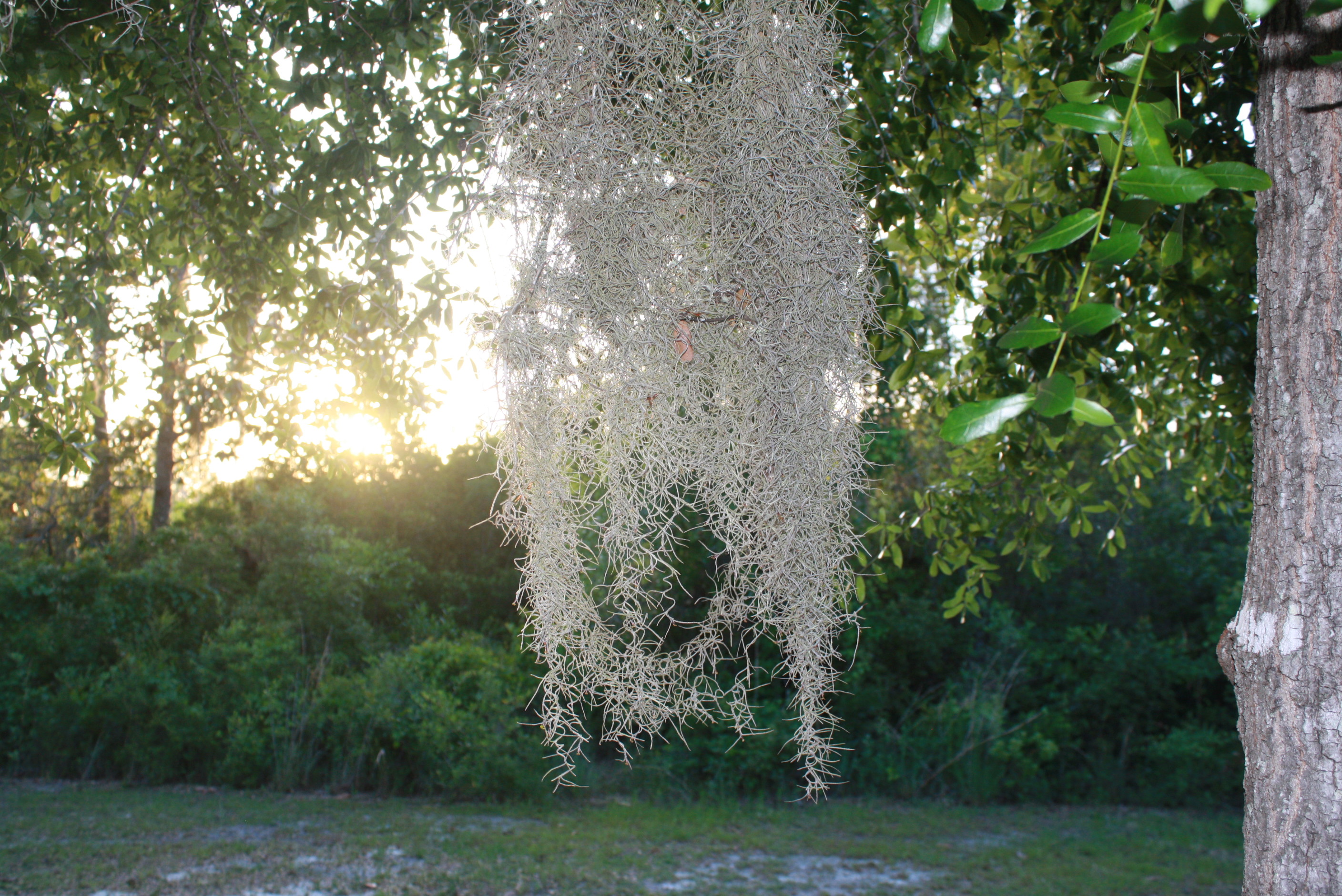
by Julie McConnell | Feb 18, 2014
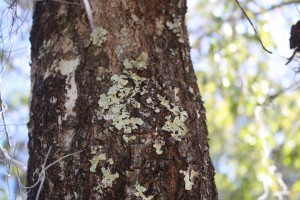
Lichen on trunk of oak tree. Image: Julie McConnell, UF/IFAS
Spanish moss and lichen have earned an inaccurate reputation for damaging trees and shrubs in the Florida landscape. Although they may be found in plants that are in decline or showing stress symptoms, they are simply taking advantage of space available to survive. Both plants are epiphytes and are obtaining moisture and nutrients from the atmosphere rather than from the plants they rest upon.
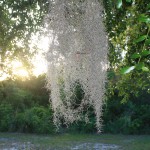
Spanish moss. Image: Julie McConnell, UF/IFAS
Lichen are more commonly found on plants that are in poor health because they need a plant that is growing slowly and access to sunlight. These conditions can typically be found in thin canopies of trees and shrubs under stress. Although they are firmly attached to the surface of the plant, they are not taking nutrients from the tree or shrub, but rather from the air and other sources such as organic debris and bird excrement. If you find lichen on your landscape plants, look further into what stress factors might be causing the plant to grow slowly such as compacted soil, extreme weather conditions, drought stress, disease or insect pressure.
Spanish moss does not harm trees and many people find it an appealing asset to their landscapes. Common misconceptions about Spanish moss include that the weight causes branches to break and that it is a host site for chiggers. Spanish moss is very light and any additional weight is typically insignificant. Although it may harbor some insects and provide nesting material for birds and other wildlife, Spanish moss in trees is not a site conducive to chiggers because they favor low-lying moist environments.
To read more about Spanish moss, lichens, and other common epiphytes please read the EDIS publication “Spanish Moss, Ball Moss, and Lichens – Harmless Epiphytes.”
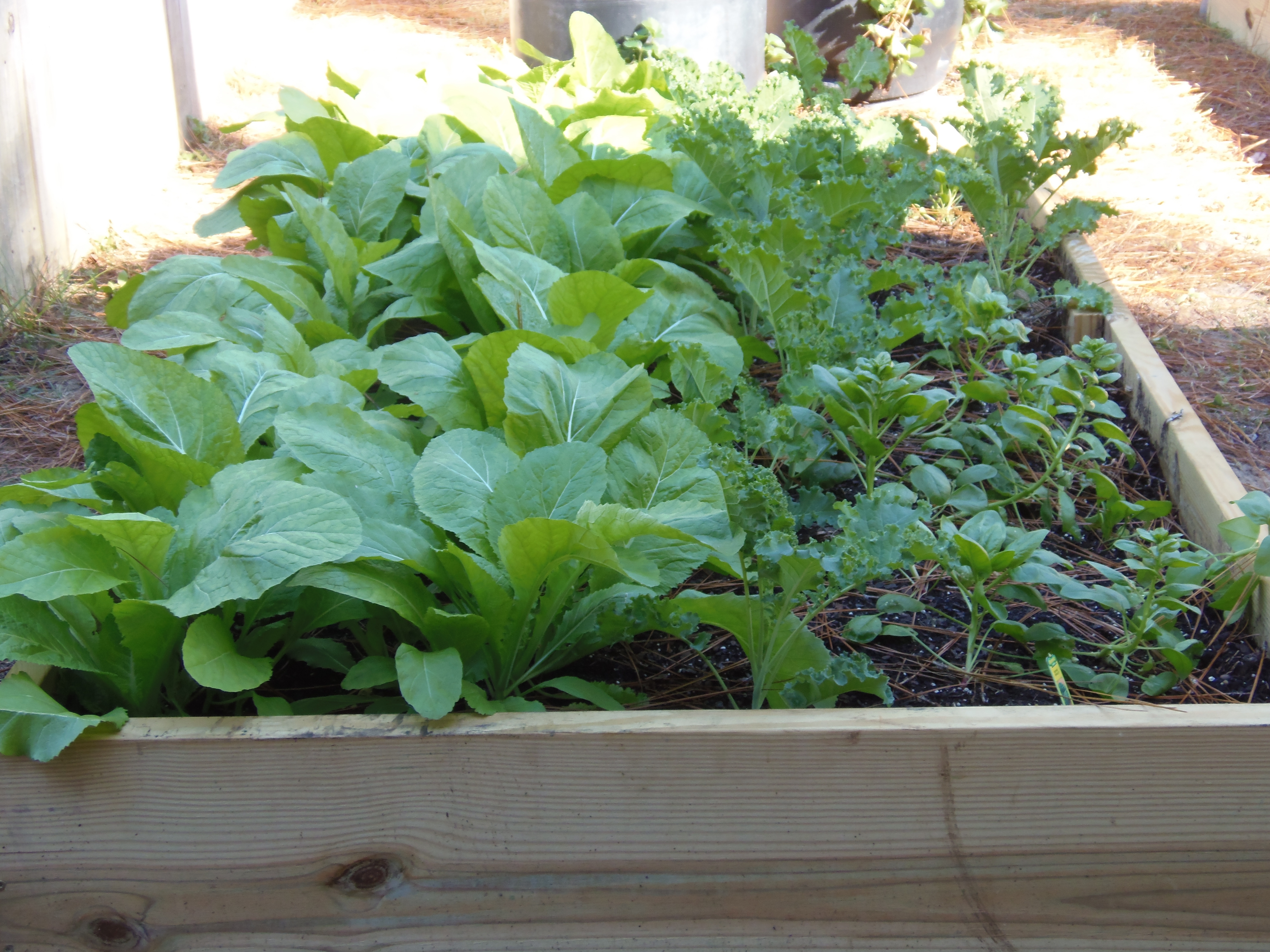
by Carrie Stevenson | Feb 18, 2014
Backyard gardens have increased in popularity the last few years, with record calls to Extension offices statewide on how to grow tomatoes and preserve produce. Along with the boom in home gardening, schools have steadily added gardens to their campuses. There are countless benefits to including children in growing their own food. Personal experience and numerous studies have shown that children improve their attitude towards fruits and vegetables and are more likely to try new foods if they’ve helped grow it themselves. Urban-dwelling youth find a safe place to interact with nature, increase their awareness of where food comes, and learn to be responsible for a living thing. Youth of all ages can gain critical math and science skills from measuring, planting, observing and problem-solving. Even toddlers enjoy scooping up soil, holding worms, and seeing the growth of a tiny seed or plant over time. Any veteran gardener will tell you that the fresh air and physical work improves their health and mental outlook.
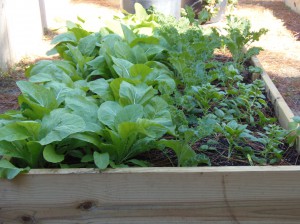
This raised bed garden is used at the Roy Hyatt Environmental Center to teach youth about gardening and provide food for numerous animals housed at the center. Photo credit: Molly O’Connor
School gardens are being used around the country to achieve all of these objectives, including intangible skills such as teamwork, confidence, and patience. The utility of gardens for lessons on art, poetry, creative writing, and music should not be underestimated; countless writers and artists have been inspired by the natural world.
Across the country, Extension programs, Master Gardeners, and 4-H staff are lending their gardening expertise to schools and learning centers from preschool to the University level. The Junior Master Gardner 4-H program is an excellent hybrid between horticultural and youth education, and is set up with curriculum and lessons for working with kids in both a classroom and field setting. The Florida Ag in the Classroom “Gardening for Grades” program has curriculum for elementary through high school levels correlated with state standards and ready to go for a classroom. Youth study soil structure, chemistry, botany, environmental science, agriculture, meteorology, and wildlife ecology in an engaging, hands-on way. In-service training workshops are held periodically to prepare teachers for beginning and teaching from a school garden, so ask your local Horticulture or Agriculture agent about these programs.
Typically, backyard gardeners, schools, or Scout groups will create a raised-bed garden, which reduces weeds and water needs and allows for easier control of soil type and maintenance. Guidelines for raised bed gardens, for home or educational institution, are available here.
Vegetable gardens aren’t the only teaching tool in the horticultural world. Butterfly and wildlife gardens are (pardon the pun) perennially popular, and are typically easy to implement. Youth may learn valuable lessons on food webs and insect life cycles in addition to the soil and botanical information. For more information on the benefits of gardening with youth, visit the UF school garden site or contact your local horticulture Extension agent.
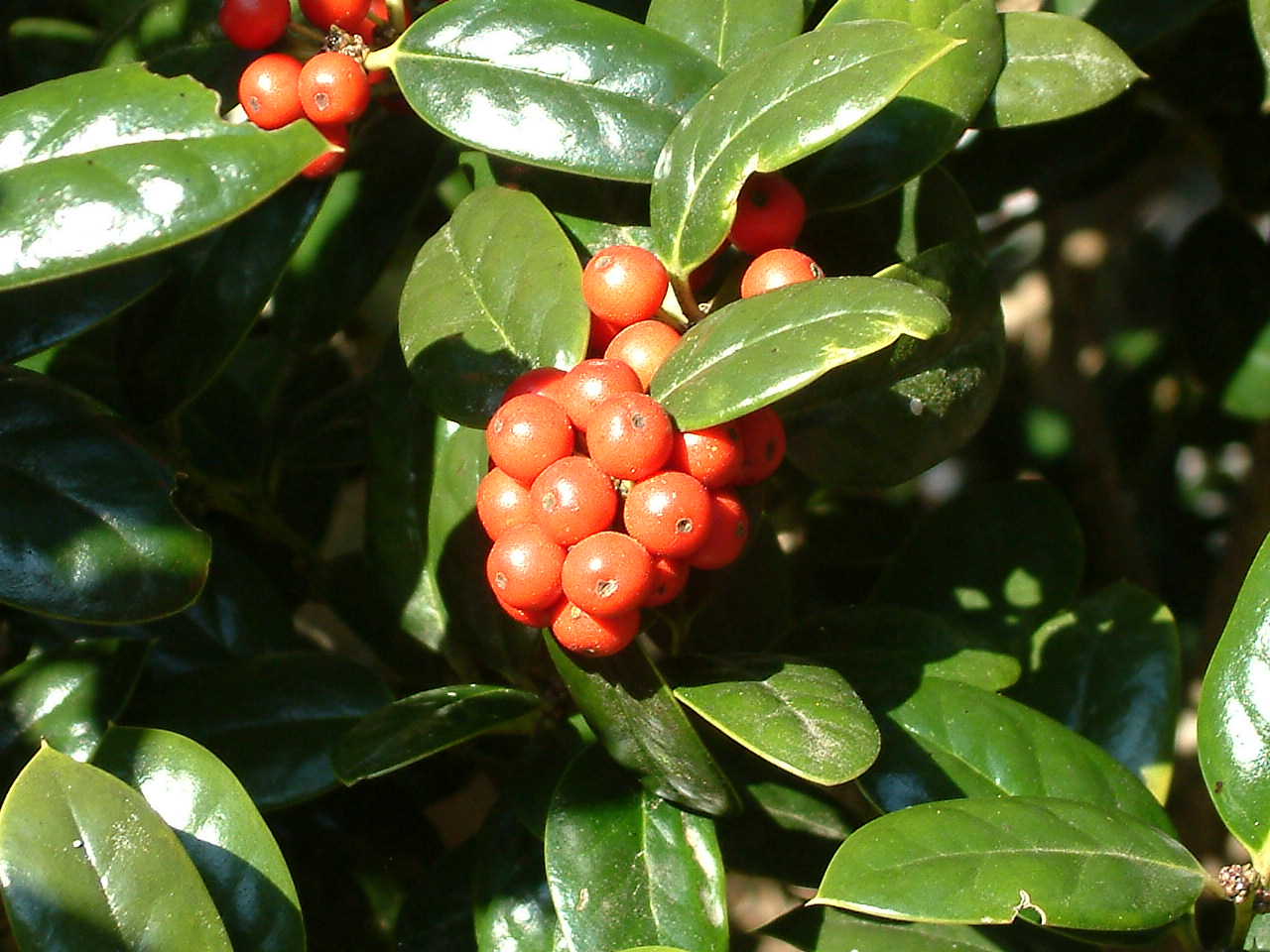
by Beth Bolles | Feb 18, 2014
Looking for a new shrub or small tree this year? Interested in one that is low maintenance and offers beautiful green color? Why not try a holly.
Hollies can be found in landscapes throughout North Florida. Many times these plants are used in foundation plantings around homes. They can help make the transition from the hard lines of a home to other parts of the yard. In other landscapes, hollies make an excellent screen, dividing property or blocking a view.
Because hollies are commonplace, they may be overlooked by homeowners who want to add an attractive new plant to the landscape. Hollies have many uses and there are new selections entering the market worth considering.
In general hollies will not need a great amount of maintenance. Once established most species will require only occasional water, fertilizer, and pruning. Many hollies have even grown well under neglected conditions. If you are one that keeps holly plants pruned as hedges, you will need to watch for the scale insect and spray plants with a horticultural oil every year.
When selecting a holly plant, it is good to know a little about the area where you want to place the plant. Hollies vary in size and ability to tolerate wet soil, so it is important to match a species with your specific site. Also consider holly leaf shapes when using the plants in areas where people walk. Some holly leaves are very stiff and sharp and could injury visitors to you home or be a nuisance when you are working in the yard.
If you are interested in the added beauty of holly berries during the year, remember to select a female plant.
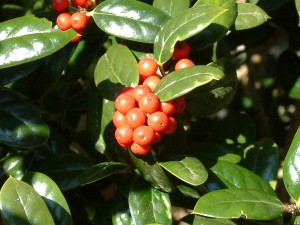
Hollies also attract bees to the landscape.
Credit: Beth Bolles, UF IFAS Extension Escambia County
Tree form hollies that you may select include the American holly (Ilex opaca), Savannah holly (Ilex x attenuata ‘Savannah’), and the Burford holly (Ilex cornuta ‘Burfordii’). All three plants will need well-drained soil. The American and Savannah holly will both reach heights between 20 and 40 feet and have a pyramidal growth form. The Savannah holly leaves will be a lighter green color than the leaves of other holly species. Burford holly has thick dark green leaves and grows about 12-15 feet in height over time.
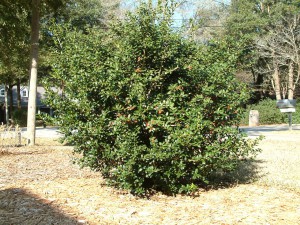
Burford holly is a beautiful holly that gives birds a place to hide.
Credit: Beth Bolles, UF IFAS Extension Escambia County
If you have a wet site, consider the Dahoon holly which can be a specimen plant or used as a screen. This plant will develop attractive grayish bark and grow about 20 feet in height with more of a spread than the previously mentioned hollies.
There are medium-sized hollies that make excellent specimen plants about 12 feet in height. ‘Festive’ holly has dark green foliage and forms dense growth in a pyramidal form. The ‘Robin’ holly has a similar growth form but displays beautiful reddish new growth. Both of these plants will need well-drained soil and full sun or partial shade.
For those areas that require smaller evergreen plants, consider a ‘Bordeaux’ yaupon holly. These plants will grow about 4 feet in height and spread and form a dense growth of stiff stems with small leathery leaves. Since these plants keep a naturally round form it is not necessary to shear them. Both hollies will tolerate a wide range of soil conditions and require little maintenance once established.
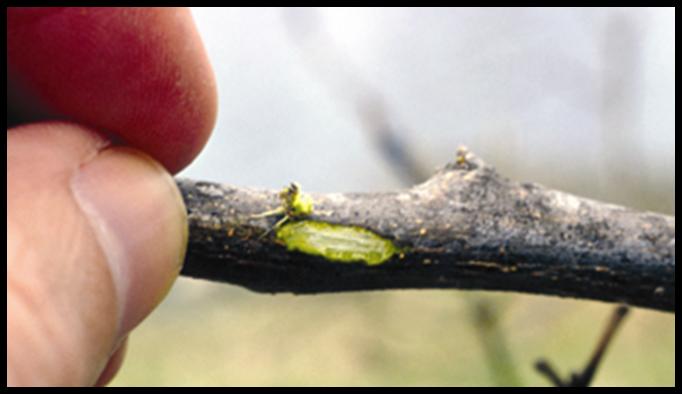
by Roy Carter | Jan 20, 2014
January and February are typically the coldest months in Florida and plants can be damaged by low temperatures. But with your help, cold-damaged plants can often recover.
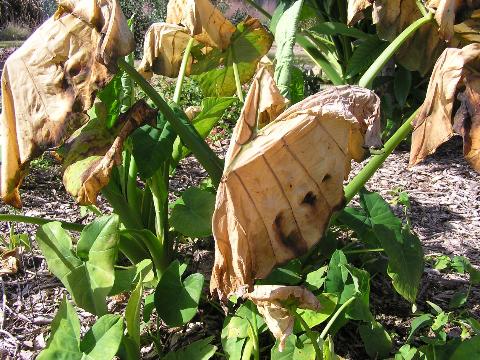
Cold damage on Ornamental. Image Credit Eddie Powell UF IFAS Extension Walton County
After a freeze, see if your plants are dry. Even injured plants need water.
Plants, however can be greatly damaged if the temperature drops suddenly. They have no time to acclimate to the freezing temperatures. Plants are damaged when ice crystals form the plant cells. The crystals expand, rupturing the cell walls and preventing the plants from maintaining shape. If severe, this can kill tender plants. On hardier plants, damaged foliage will appear wilted and curled down. In a few hours or days, it will darken and turn black. Flowers and buds my die, blacken, and drop to the ground if exposed to cold temperatures. Damaged flowers will not develop into fruit. Young branches and new growth are especially susceptible and may also blacken and die.
After freezing temperatures occur, remove damaged leaves and flowers as soon as they turn brown or black. This will help prevent diseases from attacking the plant. Pruning should be postponed until cold temperatures are no longer expected and new growth begins to appear on the plant. This is to make sure that live wood, which appears dead from losing its leaves, is not mistakenly removed from the plant. Cold damaged wood can be detected by examining the cambium layer (under the bark) of the plant. If it has black or brown discoloration, it is damaged and should be pruned back behind those points.

Living cambium layer beneath bark. Image Credit UF IFAS Pinellas County
Protect your plants from cold temperatures during the next cold front. Do this by moving potted plants indoors and covering tender landscape plants with a protective covering. Protective covering can include old bed sheet, pieces of material or fabric, and cardboard boxes. Be careful not to let the protective covering touch the plants. The surface of the covering will become as cold as the air temperatures and may damage any tender leaves it come in contact with. Also, don’t forget to remove the covering the next day when temperature raises this is important so the plants do not “bake” in the warmer temperatures. Plants placed near the house, lights, or other structures, which shelter them from wind, will be more protected than those fully exposed to the cold air.
Whatever you do, even if your landscape ornamentals have already suffered some cold injury. Do not relax your guard more frigid weather may be on the way. So, be prepared to keep your prized plants, as warm as possible, each time the weatherman predicts freezing temperatures. Plants should be fertilized in the spring, to encourage new growth. Try not encouraging any new growth, until all frost danger has passed.
For more information on freeze damaged plants contact your county extension agent and see Publication The North Florida Gardening Calendar
by Julie McConnell | Jan 13, 2014
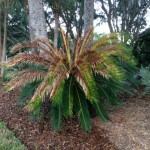
King Sago Palm. Photo credit: Mary Derrick
The wordpress-platform version Gardening in the Panhandle began in May of 2012 and had 188 views from its inception through the end of the year. This was a new online version of a long running and award winning traditional print newsletter. 2013 brought a new e-newsletter format and a ramped up effort to provide science based articles that you, the reader, find interesting and useful as you garden in the panhandle. We have gotten your attention, you visited Gardening in the Panhandle 23,422 times in 2013!
Below is a list of the top fifteen most read articles from 2013 with links so that you can visit again if you missed it. Please let us know if there are topics you would like to see covered by leaving comments or emailing one the editors Matthew Orwat mjorwat@ufl.edu or Mary Derrick mderrick@ufl.edu.
# of Hits Title Author
by Gary Knox | Jan 7, 2014
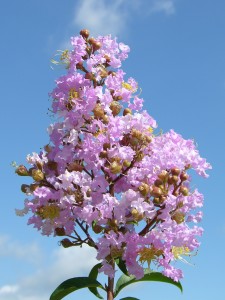
‘Apalachee’ has light lavender flowers. Photo by Gary Knox
‘Apalachee’ crapemyrtle is a statuesque small deciduous tree with lavender flowers, dark green leaves and cinnamon-orange bark. Lagerstroemia indica x fauriei ‘Apalachee’ is one of the hybrids released in 1987 from the breeding program of the U.S. National Arboretum. It grows as an upright to vase-shaped, multi-stemmed tree in USDA Cold Hardiness Zones 7a-9b.
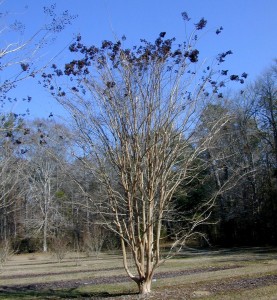
Seed capsules of ‘Apalachee’ add winter interest. Photo by Gary Gnox
Seed capsules add unexpected winter ornament to the leafless branches of the deciduous tree. Because individual flowers are packed tightly in the flower panicle, the seed capsules are correspondingly closely spaced. Persisting seed capsules add interest to the tree’s profile similar to the way dried flowers of oakleaf hydrangea continue to add interest long after the flowers have faded.
Crapemyrtle grows and flowers best in full sun with rich, moist soil but is tolerant of drought and all but wet soils. ‘Apalachee’ has good resistance to powdery mildew, very good resistance to cercospora leaf spot and moderate resistance to flea beetle (Altica sp.). This hybrid is susceptible to crapemyrtle aphid. ‘Apalachee’ performs best with minimal pruning. Crapemyrtle is best located away from pavement and structures that may be stained by fallen flowers.
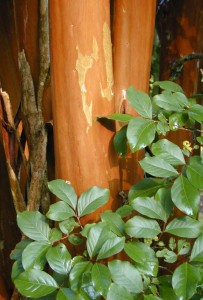
Cinnamon-orange bark of ‘Apalachee’. Photo by Gary Knox
‘Apalachee’ grew to a height of 26 feet and a width of 21 feet in 15 years at former University of Florida facilities in Monticello, Florida. It was one of the most outstanding crapemyrtles in that evaluation planting. This crapemyrtles’ form, vigorous growth, dark green leaves, lavender flowers, cinnamon-orange bark, and persistent seed capsules give it year-round appeal and allow it to stand out among crapemyrtle cultivars.
Lagerstroemia indica x fauriei ‘Apalachee’ has not yet been evaluated using the IFAS Assessment of Non-Native Plants in Florida’s Natural Areas. Without this assessment, the temporary conclusion is that Lagerstroemia indica x fauriei ‘Apalachee’ is not a problem species at this time and may be recommended.
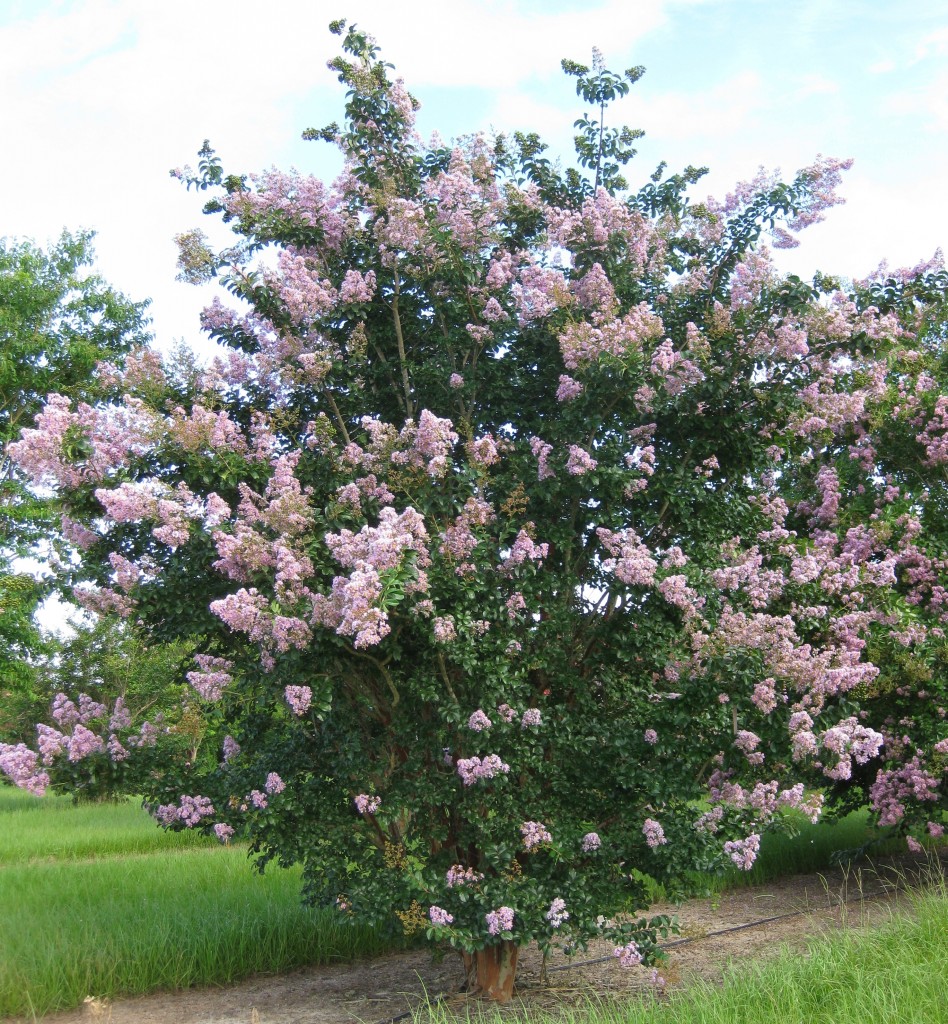
‘Apalachee’ crapemyrtle in full bloom. Photo by Gary Knox
















